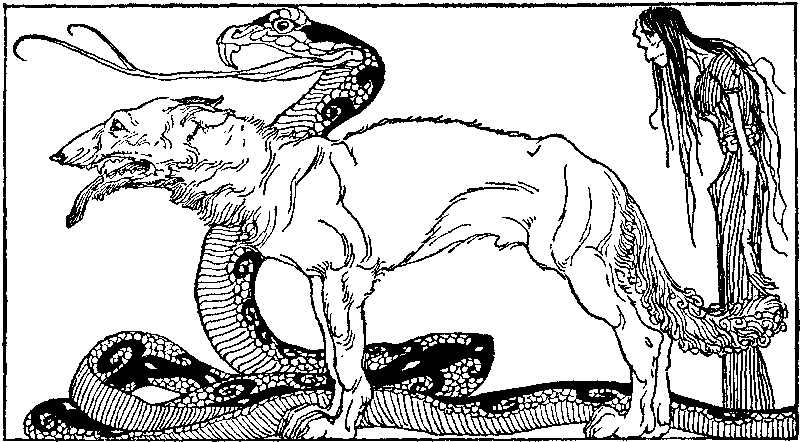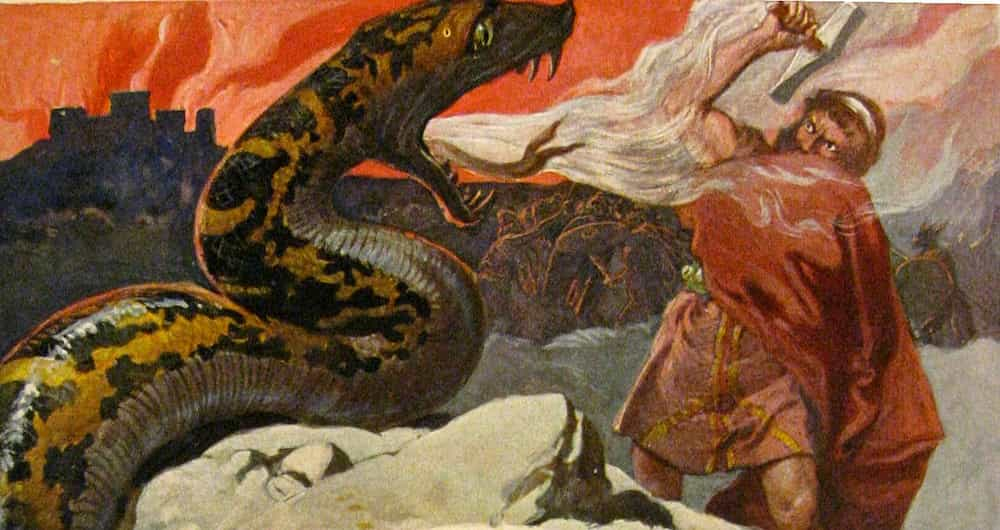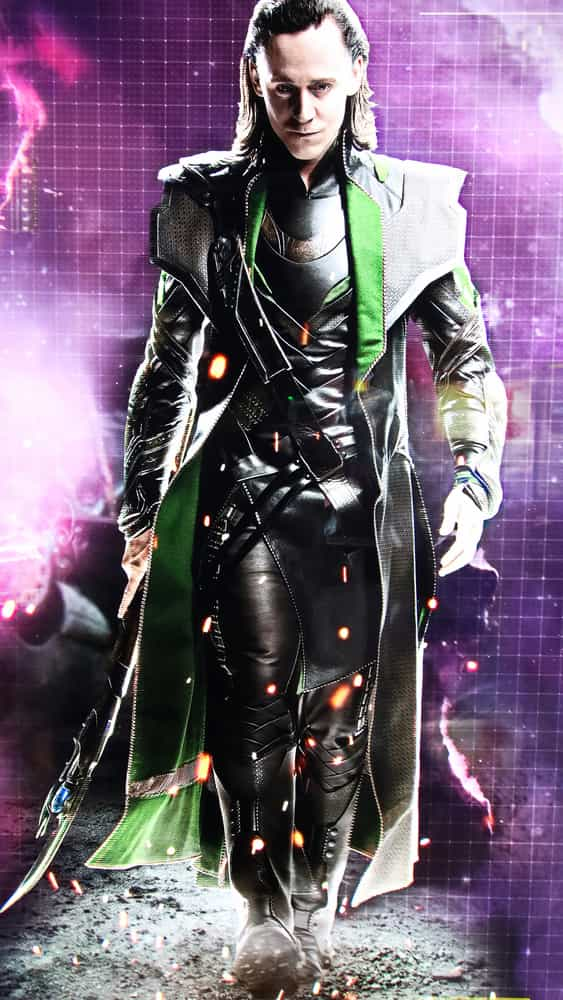When an ancient figure receives a major revival in new forms of entertainment, the details of their original story can intertwine with the conscious and unconscious changes the new bards impart into the retelling.
And with the dynamic cultural impact of Marvel’s Loki, especially in the Marvel Cinematic Universe, there are plenty of new tales blurring his already obscure origins.
As with any attempt to analyze the Viking world, the large gap of time and limited written works by the Vikings makes it difficult. The largest sources, the Poetic Edda and the works of Snorri Sturluson, were compiled or created centuries after the end of the Viking Age and the Christianization of Scandinavia.

Table of Contents
Who is Loki?
Within Norse mythology, Loki is a god known for being a trickster and “backbiter” with outstanding shapeshifting powers. He plays a key antagonistic role in the final battle of Ragnarok. Loki (also written as Loke) is one of the Æsir (henceforth written as Aesir), the primary divinities within Norse mythology.
His father was a jotunn, or a giant as per Norse mythology, named Farbauti. His mother was the goddess Laufey. In his normal form, he is described as having a pretty face that belies his wicked tongue.
Loki’s wife is the goddess Sigyn, a relatively obscure figure who is mentioned mostly in relation to Loki. She bore him two children, Narfi (Nari) and Vali, but Loki’s children were primarily the result of relationships with others.
Half of his brood came from the giantess Angrboda, who bore him three monstrous children: Fenrir the wolf, Jormungandr the World-Serpent, and Hel – ruler of the realm with the same name. His other child, Sleipnir, was the result of him mating with the stallion Svadilfare while in the form of a mare.

What does Loki do in Norse mythology?
During the ancient times described in Norse mythology, Loki had a strained alliance with the other gods. There are times when he assists them, and he sometimes plays on the confusing nature of his actions to stay close to them until he takes his schemes too far.
In this era, Loki is currently bound by the entrails of Narfi as a punishment for indirectly killing Baldr, a son of Odin. He tricked the blind god, Hoth (Hod, Hodr) into throwing a branch of mistletoe at Baldr. Frigg, the wife of Odin, had made everything in the world promise not to harm Baldr, except the mistletoe. The gods made a game of throwing things at Baldr until the shocking and sudden death.
A venomous snake sits over Loki’s prison, slowly dripping venom into a bowl held by Sigyn. The bowl can only hold so much of the poison, so Loki is drenched in it every time the bowl has to be emptied. When the venom strikes him, the force of the writhing from his agony causes earthquakes.
You may also be interested in: Until Valhalla: What Does It Mean (or is it “Til Valhalla”)?
Loki and Ragnarok
Loki plays a prominent role as an antagonist in Ragnarok, the final battle that will end all existence. He is also connected to several other beings who have a role in the battle or the events leading up to it.
After three back-to-back winters and war across the world, Loki’s grandchildren by Fenrir – the wolves Skoll and Hati – catch and eat the sun and the moon after chasing them for ages. Fenrir then finally breaks free the binding the Aesir put on him in an attempt to thwart the prophecy. The beast kills Odin and his einherjar – the souls of fallen warriors – before being slain by Vithar, Odin’s son.
Jormungandr will finally release the grasp on his own tail and begin to thrash. The massive body moving about the oceans whips up monstrous waves that overtake the land. The waves break loose Naflgar and give Loki a clear path to sail the ship to its final destination.
During the battle, Thor is the one to challenge the giant snake. While strong enough to defeat Jormungandr, the snake’s venom causes Thor to die less than ten steps away from his victory.

For his own actions during Ragnarok, Loki is supposed to break free from his bindings and captain a ship made from nail clippings over a cold and watery world in an assault on the Aesir. Once there, he is supposed to engage in battle with Heimdall, the warder god whose job is to watch over the Bifrost, the rainbow bridge to Asgard. The two will slay each other, finally putting an end to the tricks and schemes of Loki.
The damage is still done at that point, and the world plunges headlong into calamity until nothing is less. Some versions of the story feature a rebirth of a new world after the battle, but it may be an addition after the Christianization of Scandinavia.
How is Loki different in modern media?
While modern depictions of Loki usually incorporate the core elements of his character, both major and minor details are usually changed. For example, Marvel’s Loki is the adopted son of Odin and sibling to Thor and Hel who was locked away because of his father’s shame.
Some of the comics keep his half-giant, half-Asgardian lineage, but the Marvel Cinematic Universe portrays him as a frost giant runt.
Even if a feature is shared across multiple sources, the changes from one version can carry forward into others. In general, most depictions fail beyond portraying him as generally chaotic and fluctuating between neutral and evil morally.
The comic’s version of the relationship has carried through into other media, such as the version of Loki in the game Smite. This bleeding of Marvel’s take on Loki into other versions of the character is likely to be a continuing part of modern depictions.

Comic book characters are famously stylized for appealing imagery and easy recognition. Aside from Tom Hiddleston fitting the generally attractive description of Loki, the costuming is entirely the work of Marvel. Elements of the costume, especially the horns on his helmet, have since gained a stronger cultural relationship to Loki than the original character.
The sorcerer Loki of the comics has magical powers that go beyond the shapeshifting attributed to Loki in the Eddas. Feats of magic like teleportation and telekinesis would likely have earned a mention in the myths if he had them. Marvel Loki’s powers do have a mentalist bent that plays into the traditional Loki’s thematics, especially the ability to hypnotise lining up with Loki’s ability to weave lies.
Did the Vikings worship Loki?
While a being with divine power, there was no open worship of Loki by Vikings even in pre-Christian Scandinavia. He is not exactly analogous to the Devil, but his chaotic evilness and connection to Ragnarok makes him a key villain of the mythos.
Because of his notorious reputation, invocations of his name would likely be derogatory or warding in nature. Someone caught in a lie might warrant a reference to Loki, or a messy situation could be attributed to Loki. Aside from the gods being aloof from the worries of mortals, Loki was known to be bound until the end of the world.
Compared to the other Aesir, archaeologists have discovered fewer artifacts featuring depictions of him. Most that do are those like the Gosforth Cross, which shows him bound with Sigyn watching over him.
What are Loki’s symbols?
Loki has a symbolic connection to knots, tangles, and webs. While not uniquely linked to them, he also has a connection to wolves, snakes, horses, and the Viking realm of Hel. His shapeshifting powers give him a potential association with several other animals, including salmon and flies.
Most of these symbolic connections are not seen directly as a way of referencing Loki. A large, tangled snake that is eating its own tail is likely a reference to Jormungandr, but it isn’t technically a direct symbol for Loki given the serpent’s importance in Norse mythology.
Note that some sources will associate fire with Loki, but this stems from his name being exceedingly close to Logi, a fire jotunn mentioned in the Prose Edda. This belief has since been discarded by most scholars.

What is Loki’s rune?
Loki has no particular rune association. Spelling his name in runes varies depending on which version of the Futhark is being used. Notably, during the time of the Vikings, the Younger Futhark was the version in use.
The runes for Loki in that version are: ᛚᚬᚴᛁ
The third rune, Kaun, served as both the “k” and the “g” sound in the Younger Futhark, playing into the confusion between Loki and Logi.
Find out more: Norse Runes: Ultimate Guide to the Vikings’ Nordic Alphabet
What animal is associated with Loki?
Because of Loki’s shapeshifting antics, several animals are associated with him. The strongest associations come from his animalistic children: a wolf, a snake, and an eight-legged horse. However, he transforms into many different creatures throughout the various stories, including a bird, a fly, and a fish.
Loki’s shapeshifting capabilities are powerful and complete, capable of fooling other Aesir and replicating all the functions of his chosen form. He doesn’t notably favor one form over any other, so choosing just one animal to associate with him is too limiting.
What is Loki’s snake symbol called?
There are two snakes associated with Loki. The first is his child, Jormungandr. The second is the one set above him by Skadi to torture him, which is an unnamed snake, though it does have an exceedingly long life compared to most reptiles.
As mentioned earlier, Jormungandr is one of Loki’s children by the giantess Angrboda. The World-Serpent is a key figure in the foretold signs of Ragnarok.
Telling Loki’s two snake symbols apart is fairly easy. The torturing snake is pictured above a bound Loki with Sigyn catching the dripping venom. Jormungandr will usually be large relative to nearby images, or the snake will weave and bend throughout the artwork. It can sometimes be depicted with its own tail in its mouth, like an ouroboros.
Related: Valkyrie Symbol in Norse Mythology: Its Meaning and More
Are goats a symbol for Loki?
Goats are not specifically a symbol for Loki, but there is a story in the Prose Edda by Snorri Sturluson that involves Loki and a goat, with Loki serving as an accomplice to the kidnapping of a goddess.
The goddess Skadi was the daughter of a giant who had been slain by the Aesir after kidnapping the goddess Idun. While the goat’s appearance is still further into the story, Loki was an accomplice in the kidnapping. He lured Idun to the spot where she was kidnapped.
With the intent of taking revenge, she geared herself for battle and went to Asgard. Upon her arrival, the Aesir tried to talk her into holding off on her revenge. The giants and the gods weren’t always on good terms, but violence wasn’t their only interaction.

The offering from the Aesir was the option for Skadi to pick one of them to marry, but she had to select her choice based on the appearance of their feet. She accepted on the hopes of landing Baldr, but she ends up selecting Njord. The two get along alright at first, but the two couldn’t agree on where to live and eventually split.
Skadi’s counter-demand is where Loki and the goat get involved. Skadi set the condition that the gods make her laugh. Not to balk at such a task, Loki tied one end of a rope to a goat’s beard. He tied the other end to his testicles, and challenged the goat to a game of tug-of-war.
Loki and the goat made a great deal of noise in their battle before Loki fell into Skadi’s lap, causing her to laugh and fulfilling the conditions for a peaceful end to the otherwise bloody and odd story.
What is Loki’s number?
Loki does not have any strong or unique connections to any particular number. However, the number three shows up frequently in Norse mythology, although not exclusively for Loki. When Loki is bound, he is tied in three places. He had three monstrous children by Angrboda. Three winters come before Ragnarok.
Numerous other uses of three as a symbolic element exist, so it wasn’t used in any way to represent Loki himself.
Suggestions that Loki has a connection to the number 13 and its association with bad luck seem dubious at best. The story of Baldr’s death does not make a major note of the number of guests at the party in the Prose Edda.
Does Loki have a tattoo?
Loki himself is not described as having any particular tattoos within the available recordings of Norse mythology. Modern tattoos of Loki take heavy influence from sources like Marvel and Wagner. Unfortunately, there is no skin art to copy from Loki.
This means that anyone who wants a Loki tattoo will have to consult more modern sources.
What colors does Loki like?
In Norse mythology, the god Loki has no strong association with any specific colors. However, in the Marvel Cinematic Universe, where Loki stands as one of the most well-known villains, his color theme is gold and green. More recent versions have a bit of black and darker tones than the original.
This lack of color association holds true for the other divinities. Heimdall is described as the “whitest of gods” in one translation of Thrymskvitha, but it’s more in the vein of him being a shining and radiant figure than all of his outfits being white.
While a matter of opinion, this color scheme seems a fitting combination for his mix of royalty and trickery.
What does Loki’s helmet symbolize?
In Norse mythology, Loki is not known for having a helmet at all, much less a particular style of helmet. His dress and appearance is typically described as conventionally attractive. The famous helmet of Marvel’s Loki is a character design choice that has since received a minimal amount of lore attention to explain why he wears it.
The horns are supposedly a symbol for Loki’s skill as a sorcerer. In truth, the design choice likely stems from both the usage of horned helmets in the operas of Wagner and as an allusion to his closest Christian counterpart, the Devil. Early versions of Loki in the comics were more demon-like, and the revision in the ’60s brought out the golden horns.
(It’s also worth noting that horned helmets have become a popular way to show someone is a Viking even though, when it comes to what Vikings looked like, they never actually wore these helmets in reality.)
When interviewed by MTV, Tom Hiddleston expressed that the iconography is obviously satanic. Odin also has horns on his helmet, as does Heimdall – though his are less animalistic.
Wagner’s helmets also gave inspiration to Thor’s winged helmet and other Viking depictions, lending further support to a mix of reasons behind the helmet’s design choice.
